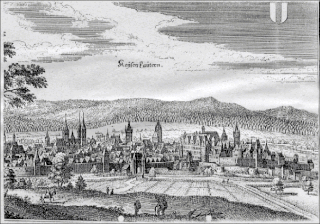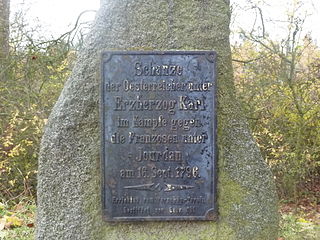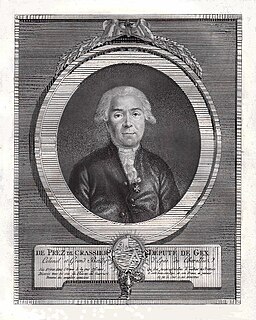Battle
While the Austrians saw themselves on the eve of losing their possessions in Belgium, the Prussian army, which had scarcely escaped from France, hastened to the aid of the Palatinate invaded by French General Adam Philippe, Comte de Custine. After having protected Koblenz by leaving a division there, Prussian field marshal Charles William Ferdinand, Duke of Brunswick-Wolfenbüttel settled in and around Limburg, where he considered himself well-situated to block French progress. On 8 November Custine ordered Colonel Jean Nicolas Houchard to assemble all his detachments and to attack the Prussians in Limburg. [Note 1] Louis Dominique Munnier was to support the attack with his corps. [1]
Houchard surprised the Prussians, who, believing themselves safe in Limburg, had established negligible defenses. The French quietly installed their batteries before the enemy even thought of defending themselves. Nevertheless, after some hesitation, the Prussians brought out their troops, who threw themselves into battle, sowing some confusion. French artillery fire forced them to retreat. The French expelled the Prussians from the city; they retreated to Montabaur, while the French fortified their positions. The entire battle took 90 minutes. [1]

The Army of the North or Armée du Nord is a name given to several historical units of the French Army. The first was one of the French Revolutionary Armies that fought with distinction against the First Coalition from 1792 to 1795. Others existed during the Peninsular War, the Hundred Days and the Franco-Prussian War.

The Battle of Kaiserslautern saw a Coalition army under Charles William Ferdinand, Duke of Brunswick-Wolfenbüttel oppose a Republican French army led by Lazare Hoche. Three days of conflict resulted in a victory by the Prussians and their Electoral Saxon allies as they turned back repeated French attacks. The War of the First Coalition combat was fought near the city of Kaiserslautern in the modern-day state of Rhineland-Palatinate, Germany, which is located about 60 kilometres (37 mi) west of Mannheim.
The Army of the Moselle was a French Revolutionary Army from 1791 through 1795. It was first known as the Army of the Centre and it fought at Valmy. In October 1792 it was renamed and subsequently fought at Trier, First Arlon, Biesingen, Kaiserslautern, Froeschwiller and Second Wissembourg. In the spring of 1794 the left wing was detached and fought at Second Arlon, Lambusart and Fleurus before being absorbed by the Army of Sambre-et-Meuse. In late 1794, the army captured Trier and initiated the Siege of Luxembourg. During the siege, the army was discontinued and its divisions were assigned to other armies.

The Battle of Arlon saw a French Republican force under the command of Amable Henri Delaage face the Habsburgs's force led by Gottfried von Schröder. The French were victorious though they suffered higher casualties than the Austrians. The action was fought during the War of the First Coalition, part of the larger French Revolutionary Wars. Arlon is located in Belgium, a distance of 30 kilometres (19 mi) west of Luxembourg city.

Nicolas Léonard Beker or Nicolas Léonard Becker or Nicolas Léonard Bagert, born 18 January 1770 – died 18 November 1840, joined the French army as a dragoon before the French Revolutionary Wars and rose in rank to become a general officer. In 1800 he married the sister of Louis Desaix, who was killed at the Battle of Marengo. He led an infantry brigade in the 1805 campaign and commanded a dragoon division in 1806 and 1807. In 1809 he became chief of staff to Marshal André Masséna but ran afoul of Emperor Napoleon and was banished from the army for several years.
The Battle of Friedberg was fought on 24 August 1796 between a First French Republic army led by Jean Victor Marie Moreau and a Habsburg Austrian army led by Maximilian Anton Karl, Count Baillet de Latour. The French army, which was advancing eastward on the south side of the Danube, managed to catch an isolated Austrian infantry regiment. In the ensuing combat, the Austrians were cut to pieces. Friedberg is a Bavarian town located on the Lech River near Augsburg. The action was fought during the War of the First Coalition.
The Battle of Kaiserslautern saw an army from the Kingdom of Prussia and Electoral Saxony led by Wichard Joachim Heinrich von Möllendorf fall upon a single French Republican division under Jean-Jacques Ambert from the Army of the Moselle. The Prussians tried to surround their outnumbered adversaries but most of the French evaded capture. Nevertheless, Möllendorf's troops inflicted casualties on the French in the ratio of nine-to-one and occupied Kaiserslautern. While the Prussians won this triumph on an unimportant front, the French armies soon began winning decisive victories in Belgium and the Netherlands. The battle occurred during the War of the First Coalition, part of the French Revolutionary Wars. In 1794 Kaiserslautern was part of the Electoral Palatinate but today the city is located in the state of Rhineland-Palatinate in Germany about 67 kilometres (42 mi) west of Mannheim.
The Battle of Pfeddersheim or Battle of the Pfrimm saw a Habsburg Austrian army led by François Sébastien Charles Joseph de Croix, Count of Clerfayt attack a Republican French army under Jean-Charles Pichegru. The Austrians defeated the French and forced them to retreat south to Frankenthal where Clerfayt won another clash a few days later. The battle occurred during the War of the First Coalition, part of the French Revolutionary Wars. The borough of Worms-Pfeddersheim is located in the state of Rhineland-Palatinate in Germany. Worms is approximately 23 kilometres (14 mi) north of Mannheim and Pfeddersheim is about 6 kilometres (4 mi) west of Worms.

André Poncet commanded a French infantry division during the French Revolutionary Wars. He joined the French Royal Army in a famous regiment and fought in the American Revolutionary War. Becoming a general officer in early 1794, he fought at Fleurus, Maastricht and other actions. He led a division in the Rhine Campaign of 1795 at Höchst and in the Rhine Campaign of 1796 at Limburg. Afterward, he held interior posts until his retirement from the military in 1811. He became mayor of his home town of Pesmes. When it was occupied by the Austrians in 1814, he was arrested and confined in the Palanok Castle in distant Transylvania for five months. He became a farmer and died in 1838 after returning to France. His surname is one of the names inscribed under the Arc de Triomphe, on Column 6.

The Battle of Pirmasens saw the French Republican corps led by Jean René Moreaux attack the Prussian force led by Charles William Ferdinand, Duke of Brunswick-Wolfenbüttel. From prepared positions, the Prussians caught the French in a deadly crossfire, forcing them to withdraw their troops. The clash happened during the War of the First Coalition, part of a larger conflict known as the French Revolutionary Wars. In 1793 Pirmasens was part of the Landgraviate of Hesse-Darmstadt but today the city is in the state of Rhineland-Palatinate in Germany, 34.4 kilometres (21 mi) south of Kaiserslautern.

The Battle of Altenkirchen saw two Republican French divisions commanded by Jean Baptiste Kléber attack a wing of the Habsburg Austrian army led by Duke Ferdinand Frederick Augustus of Württemberg. A frontal attack combined with a flanking maneuver forced the Austrians to retreat. Three future Marshals of France played significant roles in the engagement: François Joseph Lefebvre as a division commander, Jean-de-Dieu Soult as a brigadier and Michel Ney as leader of a flanking column. The battle occurred during the War of the First Coalition, part of a larger conflict called the Wars of the French Revolution. Altenkirchen is located in the state of Rhineland-Palatinate in Germany about 50 kilometres (31 mi) east of Bonn.

Sometimes called the Battle of Limburg or Second Battle of Altenkirchen or Battle of the Lahn, this was actually a single-day battle followed by a lengthy rear-guard action. The action occurred during the War of the First Coalition, part of a wider conflict known as the French Revolutionary Wars. Limburg an der Lahn is located in the state of Hesse in Germany about 31 miles (50 km) east of Koblenz. On 16 September, the Habsburg Austrian army commanded by Archduke Charles, Duke of Teschen attacked a Republican French army led by Jean-Baptiste Jourdan in its positions behind the Lahn River. The unexpected collapse and withdrawal of their right flank on the evening of the 16th compelled the French to make a fighting withdrawal that began in the evening of the 16th and continued until late on 19 September.
The Battle of Wetzlar saw a Habsburg Austrian army led by Archduke Charles, Duke of Teschen launch an attack on a Republican French army under Jean-Baptiste Jourdan in its defenses on the Lahn River. The War of the First Coalition action ended in an Austrian victory when most of the French army began retreating to the west bank of the Rhine River. On the 19th the combat of Uckerath was fought as the Austrians pursued the French left wing. Wetzlar is located in the state of Hesse in Germany a distance of 66 kilometres (41 mi) north of Frankfurt.
Pierre Garnier, comte de Laboissière was a French army general who commanded an infantry division during the War of the Second Coalition. After enrolling in a military academy in 1769, he joined a dragoon regiment in 1772 as a sous lieutenant. In 1779 he was promoted to captain. In late 1792 during the War of the First Coalition he was given command of a cavalry regiment with the grade of colonel. While serving in the Army of the Rhine he was captured by the Prussians. After a prisoner exchange he was promoted to général de brigade in October 1793. Laboissière was promoted to général de division in February 1799. He fought at Stockach and led a division at Novi. In the summer and fall of 1799 he fought in several actions near Genoa. Later he commanded troops in Switzerland. Napoleon appointed him to the Sénat conservateur in 1802, awarded him the Commander's Cross of the Légion d'Honneur in 1804 and made him a comte de l'empire in 1808. He died in Paris in April 1809. His surname is one of the names inscribed under the Arc de Triomphe, on Column 15.
The Battle of Aldenhoven saw the Habsburg Austrian army commanded by Prince Josias of Saxe-Coburg-Saalfeld attack a Republican French force under René Joseph de Lanoue. The Austrians successfully crossed the Roer River and engaged in a cavalry charge led by Archduke Charles, Duke of Teschen which routed the French and inflicted heavy losses. The War of the First Coalition battle occurred near Aldenhoven, a city in North Rhine-Westphalia, Germany located about 55 kilometres (34 mi) west of Cologne.

Claude Ignace François Michaud commanded French troops during the French Revolutionary Wars, rising to command the Army of the Rhine in 1794. After serving in a cavalry regiment from 1780 to 1783 he returned to civilian life. During the French Revolution he became lieutenant colonel of a volunteer battalion. In 1793 he was promoted to both general of brigade and general of division. He led a division at Haguenau and Second Wissembourg.
The Battle of Haguenau saw a Republican French army commanded by Jean-Charles Pichegru mount a persistent offensive against a Coalition army under Dagobert Sigmund von Wurmser during the War of the First Coalition. In late November, Wurmser pulled back from his defenses behind the Zorn River and assumed a new position along the Moder River at Haguenau. After continuous fighting, Wurmser finally withdrew to the Lauter River after his western flank was turned in the Battle of Froeschwiller on 22 December. Haguenau is a city in Bas-Rhin department of France, located 29 kilometres (18 mi) north of Strasbourg.
The siege of Landau saw a corps from the Kingdom of Prussia commanded by Frederick Louis, Prince of Hohenlohe-Ingelfingen lay siege to a 3,800-man French Republican garrison led by Joseph Marie Tennet de Laubadère. Since the Prussians lacked siege cannons, they tried to starve the French defenders into surrender by blockading the city. In late December, the French Army of the Moselle under Lazare Hoche and Army of the Rhine under Jean-Charles Pichegru defeated the Coalition armies opposed to them, forcing the Prussians to raise the War of the First Coalition siege.
Paul-Alexis Dubois commanded French divisions during the War of the First Coalition and was killed in action fighting against Habsburg Austria. He enlisted in a French infantry regiment in 1770 and transferred into the cavalry in 1776. Thereafter he served in several different cavalry and infantry regiments. From sous-lieutenant in 1791, he served in the Army of the Moselle and was rapidly promoted to general of brigade by August 1793. After briefly commanding an infantry division in the Army of the Rhine at Wissembourg he switched back to the Army of the Moselle to fight at Kaiserslautern before being wounded at Froeschwiller in December 1793.

Jean Étienne Philibert de Prez de Crassier or Étienne Desprez-Crassier was a French political and military leader in the early years of the French Revolutionary Wars. Despite being from the minor nobility, he entered the French Royal Army as a cadet at the age of 12 because of his family's poverty. He fought in the War of the Austrian Succession and the Seven Years' War, becoming a colonel in 1785 and retiring two years later. Voltaire lent him the money needed to recover the Deprez family property. He was elected to the Estates General as a nobleman in 1789. After being promoted to lieutenant general he led a division at Valmy in 1792. He became commander of the Army of the Rhine and Army of the Western Pyrenees. Imprisoned during the Reign of Terror, he was released and restored to his former rank but retired in 1796.









